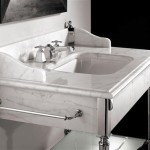How to Fit a Bathroom Vanity Sink Unit
Installing a bathroom vanity sink unit can be a rewarding DIY project, bringing a touch of elegance and functionality to your bathroom. It involves a combination of plumbing, carpentry, and careful measurement to ensure a seamless fit and a beautiful finish. This guide will walk you through the steps involved in fitting a bathroom vanity sink unit, providing you with a comprehensive understanding of the process.
Step 1: Preparation and Tools
Before embarking on the installation, it's crucial to gather the necessary tools and materials. This will ensure a smooth and efficient workflow. You'll need:
- Bathroom vanity sink unit
- Level
- Measuring tape
- Pencil
- Screwdriver
- Adjustable wrench
- Plunger
- Caulk gun
- Silicone sealant
- Safety glasses
- Work gloves
- Plumbing tape
- Drain pipe wrench
- Pipe cutter (if necessary)
- Drill with appropriate bits
Additionally, ensure that you have the appropriate plumbing supplies, such as a shut-off valve, flexible water supply lines, and a drain assembly. It's also recommended to have a helper on hand, especially for heavier components.
Step 2: Removing the Old Sink
Before installing the new vanity, you must remove the existing sink. This typically involves several steps:
-
Turn off the water supply.
Locate the shut-off valve for the sink and turn it off completely. This will prevent any water from flowing during the removal process. -
Disconnect the water supply lines.
Use an adjustable wrench to loosen the nuts connecting the water supply lines to the sink. If the nuts are stubborn, you can use a pipe wrench for added leverage. -
Disconnect the drain.
Unscrew the drain assembly from the sink and remove it. You may need to use a drain pipe wrench for this step. -
Remove the sink.
Carefully lift the sink from its base, taking note of any screws or mounting brackets that hold it in place. If the sink is heavy, use a helper to ensure safety.
Once the old sink is removed, clean the area thoroughly to prepare for the installation of the new vanity.
Step 3: Installing the Vanity
With the old sink removed, you're ready to install the new vanity unit. This process involves several stages:
-
Position the vanity.
Carefully position the vanity unit against the wall, ensuring it's level and centered using a level. Make sure the vanity is in the desired location before proceeding. -
Mark the wall.
Using a pencil, mark the locations on the wall where the vanity will be attached. This will help guide the drilling process later. -
Drill pilot holes.
Using a drill and appropriate bits, create pilot holes at the marked locations. These holes will provide a starting point when drilling for the mounting screws. -
Secure the vanity.
Attach the vanity to the wall using the provided mounting screws. Make sure the screws are securely fastened and the vanity is stable. You can use a level to ensure proper alignment throughout the process.
Many modern bathroom vanities employ a "floating" design, where the vanity is suspended from the wall rather than resting on the floor. In such cases, a different installation method is employed, typically using a specialized bracket system.
Step 4: Connecting the Plumbing
Once the vanity is secured, you need to connect the plumbing. This step includes:
-
Connecting the water supply lines.
Attach the flexible water supply lines to the shut-off valve and the vanity faucet. Make sure the connections are tight and secure using adjustable wrenches. Wrap the threads with plumbing tape to prevent leaks. -
Connecting the drain assembly.
Attach the drain assembly to the sink and connect it to the drain pipe. Ensure the connection is tight and secure, as leaks can cause significant damage and inconvenience. If necessary, you can use a pipe cutter to adjust the drain pipe length. -
Turn on the water supply.
Once the plumbing is complete, turn the water supply back on and check for any leaks. Tighten any loose connections if necessary. -
Test the drain.
Run water into the sink and make sure the drain works correctly. If there are any clogs, use a plunger to clear them.
After testing the plumbing and ensuring everything is working properly, you can proceed to the final stages of the installation.
Step 5: Finishing Touches
Finally, you'll need to add the finishing touches to complete the installation. This might include:
-
Caulking.
Apply silicone sealant around the edges of the vanity where it meets the wall to prevent water damage and create a professional finish. -
Installing the mirror and accessories.
If the vanity comes with a mirror and accessories, mount them according to the manufacturer's instructions. Ensure they are aligned with the vanity and other fixtures in the bathroom. -
Cleaning.
Wipe down the vanity and surrounding area to remove any dust or debris from the installation process. Enjoy your new bathroom vanity!
Installing a bathroom vanity sink unit requires careful planning, attention to detail, and a bit of patience. By following these steps, you can ensure a successful installation and enjoy the beauty and functionality of your new vanity unit.

How To Install A Bathroom Vanity

Installing A Vanity Unit

How To Install A Vanity Unit Wash Basin Bathroom Ideas

How To Diy A Bathroom Vanity Unit Wood Create

How To Install A Vanity Unit Wash Basin Bathroom Ideas

How To Fit A Vanity Unit Big Bathroom

How To Diy A Bathroom Vanity Unit Wood Create

How To Install A Vanity Unit Victorian Plumbing

How To Diy A Bathroom Vanity Unit Wood Create
How To Make A Bathroom Vanity From Vintage Furniture Upcycgirl
Related Posts







